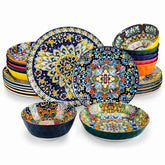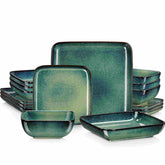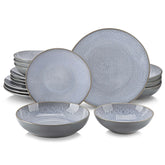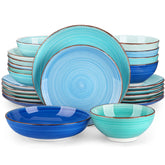Choosing the Perfect Dinnerware Set: Exploring the Differences between Sets for 4 and Sets for 6
Setting the table with a beautiful dinnerware set adds elegance and style to any meal. When it comes to choosing the right dinnerware, considering the size of your household and entertaining needs is crucial. In this blog, we will explore the differences between dinnerware sets for 4 and sets for 6. From the number of pieces included to the versatility and functionality of each set, understanding these distinctions will help you make an informed decision and find the perfect dinnerware set that suits your dining requirements.
Dinnerware Sets for 4
Dinnerware sets for 4 typically include a standard collection of plates, bowls, and mugs designed to accommodate a smaller household or intimate gatherings. These sets often consist of:
Dinner Plates: Sets for 4 typically include four dinner plates, which are the main serving plates for the meal. They are typically around 10 to 12 inches in diameter.
Salad Plates: Four salad plates are commonly included in sets for 4. These plates are smaller in size, around 8 to 9 inches in diameter, and are used for appetizers, salads, or desserts.
Soup/Cereal Bowls: Sets for 4 typically provide four soup or cereal bowls, which are deeper and broader than the salad plates. These bowls are ideal for serving soups, stews, cereals, or pasta dishes.
Mugs: Four mugs are usually included in sets for 4. They are perfect for enjoying a hot cup of coffee, tea, or other beverages.
Dinnerware Sets for 6
Dinnerware sets for 6 are designed to accommodate larger households or gatherings where additional guests may be entertained. These sets typically include:
Dinner Plates: Sets for 6 consist of six dinner plates, providing extra capacity for larger meals or hosting additional guests.
Salad Plates: Six salad plates are included in sets for 6, allowing for a larger number of appetizers, salads, or desserts to be served.
Soup/Cereal Bowls: Sets for 6 usually provide six soup or cereal bowls, accommodating a larger group for soups, stews, cereals, or pasta dishes.
Mugs: Six mugs are commonly included in sets for 6, offering ample cups for serving hot beverages to a larger group.
Considerations and Versatility
When deciding between a dinnerware set for 4 and a set for 6, there are several factors to consider. If you have a smaller household or frequently entertain a smaller number of guests, a set for 4 may be sufficient. It offers a more intimate dining experience and ensures that you have enough pieces for your immediate needs.
On the other hand, a dinnerware set for 6 provides greater flexibility and allows you to accommodate unexpected guests or larger gatherings. It is suitable for growing families, those who frequently host dinner parties, or those who enjoy entertaining friends and relatives.
Additionally, it is worth considering whether you prefer having extra pieces for replacements in case of breakage or for larger events. Some people also appreciate the option of having additional dinnerware on hand when dishwasher or sink space is limited.
Style and Design Options
In addition to the differences in size and capacity, dinnerware sets for 4 and sets for 6 also offer a wide range of style and design options to suit different preferences and aesthetics.
Patterns and Colors: Dinnerware sets come in a variety of patterns and colors, ranging from classic and traditional designs to modern and contemporary styles. Sets for 4 and sets for 6 often feature similar patterns, allowing you to choose the one that complements your dining table and overall decor.
Materials: Dinnerware sets can be made from various materials such as porcelain, stoneware, bone china, or earthenware. Each material offers unique qualities in terms of durability, elegance, and heat resistance. Consider the material that best fits your lifestyle and desired level of sophistication.
Shapes and Textures: Dinnerware sets may also differ in terms of shapes and textures. Some sets feature smooth and sleek surfaces, while others have textured or embossed patterns that add visual interest to the table. Consider the style that resonates with your personal taste and the overall ambiance you wish to create.
Additional Pieces: Some dinnerware sets, especially those for 6, may include additional pieces beyond the basic plates, bowls, and mugs. These can include serving platters, serving bowls, gravy boats, or butter dishes. If you frequently host formal dinners or require specialized serving pieces, a set for 6 may provide more comprehensive options.
Mix and Match: Another option is to mix and match dinnerware sets for 4 and sets for 6 to create a unique and personalized table setting. You can combine different patterns or colors within the same material to add visual interest and showcase your creativity.
Conclusion
Selecting the ideal dinnerware set, whether for 4 or 6, involves considering factors such as household size, entertaining needs, style preferences, and desired additional pieces. By understanding the differences between these sets and exploring the various design options available, you can find the perfect dinnerware that not only meets your functional requirements but also enhances your dining experience. Remember, dinnerware sets are an investment in both practicality and aesthetics, so choose wisely and enjoy the pleasure of beautifully set tables and memorable meals.













